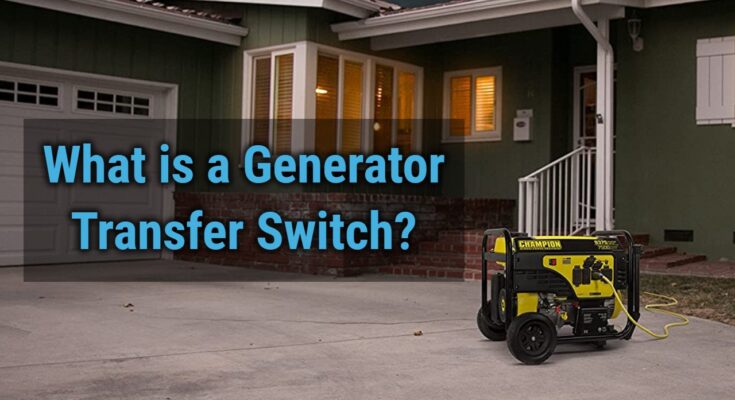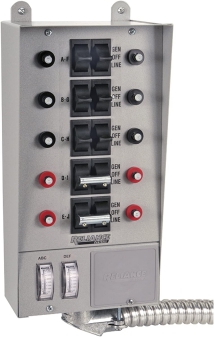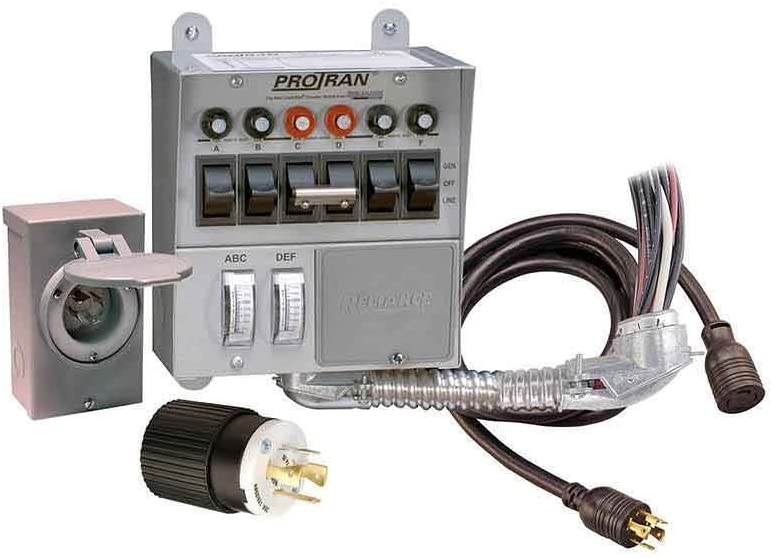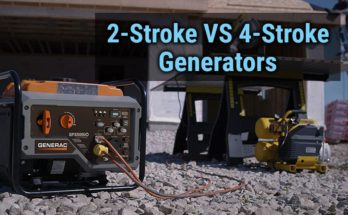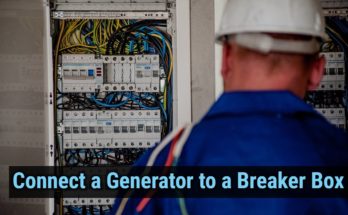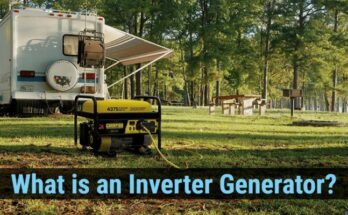After buying a generator to ride you through the next power outage, the second thing you buy should be a generator transfer switch. It gives you the hassle-free connection of the generator with the whole circuit of your house.
It will turn out to be particularly useful when you don’t want to run so many cables through the windows of your house, which may raise a safety concern.
Table of Contents
What is a Transfer Switch and How Does It Work?
A generator can be either portable or stationary; the main reason anyone buys a generator is that it supplies you with necessary energy when none is coming out through the electrical outlet of your home.
For a generator to be able to supply the electricity to the equipment and appliances of your house, it must be connected to the electrical circuit of your house, and this is achieved with the help of a transfer switch.
As the name suggests, a transfer switch is a switch that makes and breaks the connection in the electrical path.
A transfer switch is a device that lets you connect the generator to the electrical supply of the house and makes the power backup more efficient, simple, and hassle-free. It is generally difficult to connect the generators to the house without the transfer switch, and it is quite dangerous too.
The number of circuits which can be powered by one generator will depend on how much power your generator can supply.
When the grid fails to supply the power, the transfer switch transfers that power from the generator. The transfer switch can be either manual or automatic. It also detects the power outage and power in.
Types of Transfer Switches
Transfer switches are available mainly in two types: automatic or manual. Normally the automatic transfer switch is used for the stationary transformer and a manual transfer switch for the portable generator.
The transfer switches also make sure that the generator and the grid don’t get connected, reducing the risk of back feeding.
Automatic Transfer Switch
An automatic transfer switch is a hassle-free option as you don’t need to turn it on and off manually whenever the power goes out.
The automatic transfer switch has the ability to detect the power outage, and upon detection of a power outage, it gives the signal to the generator to start. When the generator starts, it disconnects the grid from the house circuits and connects the generator’s power, and voila! the power is back.
When the grid power comes back, it disconnects the generator and connects the grid back to the house. At that moment, it lets the generator run at a slow speed for a few seconds for the cooldown of the engine, and then it gives the signal to shut down.
With this switch, you get to choose the priority circuit of the house, and it will only supply the electricity to that circuit.
The functionality it provides comes with the cost. Automatic transfer switches are costlier than manual transfer switch and are mainly used for stationary generators.
Manual Transfer Switch
Compared to the automatic transfer switch, the manual transfer switch will need the helping hand to transfer the generator’s power to the house circuits.
When the power goes out, you will need to turn on the generator and press a switch, and then only it will disconnect the grid and connect the generator. Plus, you will need to manage the load which the generator sees manually.
The manual transfer switches are generally best suited for portable generators, and based on their NEMA rating; you can install them either inside or outside of the house.
The notable thing is they are cheaper than the automatic transfer switches.
Why Do You Need a Transfer Switch?
When the next storm hits and power goes out, you may not want to lay down the extension cords all around the house to supply the electricity to the necessary appliances; instead, you want to be ready.
To have a hassle-free power transfer from the generator to your house, you require a transfer switch.
Besides, connecting the generator directly to the house is an extremely dangerous job. It increases the chances of electrocution and back feeding, which isn’t safe for anyone in the house.
The generator may even supply the power to the unenergized transfer lines in the grid, and some workmen may get electrocuted. Or it can happen another way around, too; when power returns, the grid and generator are both providing power to your appliances that may damage your appliances and generator as well, plus it becomes equally unsafe.
If you want to run the hard-wired appliances in the house, which you can’t connect through an extension cord, you need a transfer switch.
And legally, the NEC 700.5 and 701.5 code requires you to power any appliances in the house through the transfer switch only.
What is the Best Transfer Switch?
As we have seen, what is a transfer switch? how it works, and why you need one?; now is the time to choose the best transfer switch, and to help you with that, we present you with these two transfer switches from the reliance controls.
1. Reliance Controls 51410C Pro/Tran 10-Circuit Indoor Transfer Switch – For Generators up to 12,500 Watts
Reliance has an excellent reputation for its quality products for industrial, domestic, and as well as commercial use. And this transfer switch is no different. It is designed to be installed fast without causing too much hassle, either at home or in the workplace.
With that being said, for easy attachment to the load center, the transfer switch features an 18-inch flexible conduit whip. With the installation of this transfer switch, you will be able to power up to 10 circuits of your house, and you can choose which circuits will be powered and which will not.
The transfer switch has a maximum running watt of 12,500, which means you can connect the generator with an output rating of up to or less than 12,500 watts.
The appearance of the transfer switch has a high height to width ratio means the switches are arranged vertically and are of a push-button style.
With this transfer switch, you can either have a maximum of 10 single-pole circuits or 5 double pole circuits. The transfer features 6 15-A single pole circuit breakers and 4 20-A single pole circuit breakers.
Besides, the kit comes with everything, so that you will need to have a proper functional setup, and it is one of the best transfer switches out there.
2. Reliance Controls 31406CRK 30-Amp 6-circuit Transfer Switch Kit – For Generators up to 7500 Watts
This transfer switch from Reliance Controls has the horizontal arrangement of toggle switches, and to protect the branch circuits, each circuit will have a 15-20 A circuit breaker. You can power a maximum of 6 circuits with the installation of this transfer switch.
The toggle switch makes it easier to choose between GEN and LINE mode. Also, you can select the off mode, which will isolate the circuit from both power sources.
Another advantage of this transfer switch is that it comes with a built-in wattmeter, which displays how much load is on the generator. This means you won’t have to worry about the overloading; just have a look at the meters.
Moving on, the transfer switch features a 30-Amp NEMA power inlet box, which facilitates the direct connection to the load center from a remote point.
Besides, to make the installation a quick and easy process, it has a Built-In junction box for hardware installation, and that is patented.
The kit includes the circuit breakers, wattmeter, junction box, power cord, plug, etc., contributing to the transfer switch’s functionality and making it the best automatic transfer switch.
What to Look for when buying a Transfer Switch?
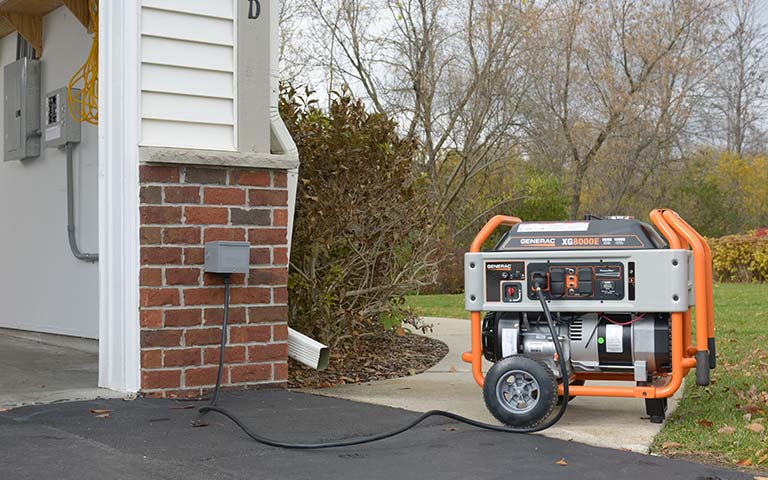
To pick the best transfer switch, you will need to keep in mind these few things mentioned below.
Things Included
This is an important consideration; make sure the kit comes with all the necessary accessories that you may require. This makes the installation of the transfer switch much simpler and easy.
Go for the transfer switch, which comes fully wired internally, and this will save you the labor cost if you plan on hiring an electrician.
And don’t go for the ones which don’t include all the cords of your need. We suggest that you buy the transfer switch from the respected manufacturers who provide all the necessary items with the kit.
Wattage
This is the most important consideration while buying a transfer switch. The wattage rating of the transfer switch depends on the max power which you are going to transfer from the generator to the household through the transfer switch.
Buy the transfer switch, which can easily accommodate the portable generator. This means if the generator is capable of supplying the 7000 running watts, then the transfer switch should be able to handle that wattage.
UL/CUL Certification
Most of the transfer switches come with the UL/CUL certificates, which means the transfer switches follow the rules that NEC has set and should be strictly followed.
But to be on the safe side, make sure the transfer switch comes with the UL/CUL certifications.
Type of Transfer Switch
The main types of transfer switches are automatic and manual transfer switches. The selection of the transfer switch is based on the generator type.
For a portable generator, go with the manual transfer switch, while for the stationary generator, the automatic transfer switch will be more suitable.
Warranty
The transfer switch specifications don’t matter if it offers very little warranty. The warranty generally gives an idea about the quality of the product. If it is less means the brand itself has no confidence in the product.
We suggest buying the transfer switch from the reputed manufacturer who provides a decent warranty on the transfer switch.
FAQs
Q. Why Is a Generator Transfer Switch Necessary?
To power, the appliances of your house, the easiest and safest way is through a transfer switch.
The NEC requires you to have the transfer switch. The transfer switch prevents the back feeding as it can damage the generator, cause fires, or electrocute a person.
Besides, it isn’t convenient to run a few extension cords from the generator to the house, which can only power a few electrical equipments, while the transfer switch can power the hardwired equipment as well.
Q. Do You Need a Permit to Install the Transfer Switch?
Yes, you will require the permit if you want to install the transfer switch to your house. It is just to keep track of the amenities which different homes have.
Generally, the electrician who is going to install the transfer switch takes care of the permitting process. He just takes your signature on the required documents, and he takes care of another process.
Make sure you consult about this with an electrician that he handles the permitting process or not.
Q. How Big of A Transfer Switch Do I Need?
The selection of the transfer switch depends on how much power you are going to pass through the transfer switch.
This means, to power the whole house, the rating of the transfer switch will be equal to the service entry, but to power some portion of the house, the smaller size will do, which is more or the same as the power transfer.
Q. How Much Does It Cost to Install the Transfer Switch?
The cost of installation of the transfer switch varies based on many factors associated with it.
The first and foremost is the type of transfer switch; a manual transfer switch will be cheaper than an automatic transfer switch.
To get a specific price, you may need to contact the local electrician. It generally takes 3-4 hours to install the transfer switch, which may have a labor cost ranging from 200$ to 600$.
Besides, the cost will also depend on the wattage, accessories included in the kit, and your area’s locality. If the living cost is high, then it will cost you more.
Further Reading:
Best Inverter Generators of 2024 | Comparison & Reviews
Best Solar Generators of 2024 | Top Picks & Reviews
Reviews of Best RV Generators in 2024
Single Phase Vs Three-Phase Generators

